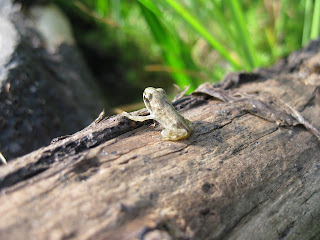"At the same time as amphibian populations are in decline around the world, new species are being discovered at a surprisingly high rate, especially in the less explored tropical rainforests: currently, over 100 new species are being described each year.
A report by Eric Rittmeyer and colleagues on two new species of frog raises the question: how small can adult frogs be?
In the UK, our Common frog Rana temporaria develops from small eggs into tadpoles that metamporphose into froglets about 8mm long. They then grow into adults about 10 times longer.
 |
| Juvenile Common frogs leave the pond at about 8mm in length, with the potential to grow 10 times longer |
So far, the smallest is Paedophryne amauensis with adults measuring in at 7.7 mm on average. These tiny frogs are direct developers (i.e. no tadpole stage) and have piercing insect-like calls. As in most miniaturised amphibians, they show specialised skeletal features such as reduced digits."
 |
| The smallest adult frog discovered in Papua New Guinea, measuring 7.7mm in length |
2012 Ecological Guild Evolution and the Discovery of the World's Smallest Vertebrate. PLoS ONE 7(1): e29797. doi:10.1371/journal.pone.0029797
- You can read the full journal article at PLoS ONE here: Rittmeyer et al(2012) in Plos-1 volume 7 issue 1.
- You can find out more about the UK's species of frog at the Froglife website here
You can help support amphibian conservation and enable us to develop research through becoming a Froglife Friend. Find out the difference you can make for just £1.50 a month here.
Photos: Sivi Sivanesan and Rittmeyer et al.

No comments:
Post a Comment